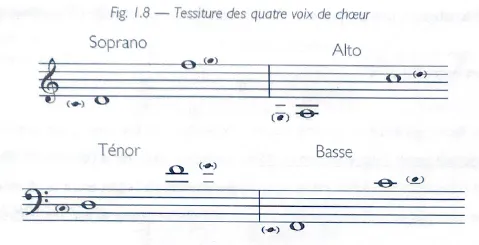Chapter 1: Fundamentals
Intervals
In 4-part harmony, we’ll consider 2 aspects of intervals: their type (melodic or harmonic), and their quality (consonant or dissonant). They will require a different treatment according to their type and quality.
Interval Types
There are two types of intervals:
- Melodic: Intervals played consecutively (i.e. a melody)
- Harmonic: Intervals played simultaneously (i.e. chords.)
In 4-part harmony, just like in species counterpoint, melodic and harmonic intervals will be treated differently and follow a slightly different set or rules.
When treating melodic intervals, we’ll be more interested in the melodic direction and making sure the line is easy to sing. On the other hand, when treating harmonic intervals, we’ll be interested in tonal fusion, chords, and voice-leading.
In 4-part harmony, we’ll be focusing more on harmony than in species counterpoint. Nonetheless, we’ll still want to consider the melodic aspect.
Interval Quality
Consonances
- There are two types of consonant intervals: perfect & imperfect.
- Perfect consonances tend to sound ‘empty’, so we’ll try to hide them.
- Imperfect intervals sound more ‘rich’.
| Perfect Consonances | Imperfect Consonances |
|---|---|
| Perfect Octaves (P8) | Major Thirds (M3) |
| Perfect Unisons (P1) | Minor Thirds (m3) |
| Perfect Fourths (P4) | Major Sixths (M6) |
| Perfect Fifths (P5) | Minor Sixths (m6) |
The perfect fourth is generally considered like a consonance, except when forming an interval with the bass line, in which case it will be considered dissonant. (see more with second inversions)
Dissonances
Other intervals are considered dissonant, some of which are considered “soft” and some of which are considered “hard”
| Soft Dissonances | Hard Dissonances |
|---|---|
| Major Seconds (M2) | Minor Seconds (m2) |
| Perfect Fourth (P4) | Major Sevenths (M7) |
| Minor Sevenths (m7) | Minor Ninths (m9) |
| Major Ninth (M9) |
Other augmented and diminished intervals are considered “soft”
The triton (d5 or A4) is generally considered like a soft dissonance in the context of tonality, although in some other musical contexts, it could be considered a consonance. In 4-part harmony, we’ll be treating it like a dissonance.
Enharmonic Intervals
Enharmonic intervals are intervals which sound identical, but are spelled differently. Even though they sound the same, they don’t occupy the same musical function.
A note with a sharp will tend to resolve upward, while a note with a flat tends to resolve downward.
One of the most important intervals we’ll come across is the augmented second (present in the minor harmonic scale), which sounds identical to a minor third, but which appears in specific contexts.
Major Scale
In 4-part harmony, we’re interested in functions rather than in the notes of the scales. This means we’re interested not only in the note themselves, but in the chords they form together.
The system we’re using to refer to those chords is called “functional harmony”. We’re using roman number (I, II, II, IV, V, VI, VII) where “I” corresponds to the triad built on top of the tonic (first note of the scale)
Constitutive Chords
If we build a triad on top of each degree of the Major scale, we get this
| I | II | III | IV | V | VI | VII |
|---|---|---|---|---|---|---|
| Maj | min | min | Maj | Maj | min | dim |
Where:
- I, IV and V are Major
- II, III and IV are minor
- VII is diminished
Because of its dissonant nature, VII is rarely used, and will often times be interpreted as V instead.
❤️ Note: I strongly recommend learning the constitutive chords by heart, it will solve some headache in the future. One way I recommend doing so is to associate them with the white keys on the piano for future reference.
Tessitura
Since 4-part harmony is a “strict” compositional style, the writing of all exercises should be arranged using the classical four choir voices. from highest to lowest, here are the names of the voices:
- Soprano
- Alto
- Tenor
- Bass
Tessitura (Vocal Ranges)
Here’s a reference guide for the minimum and maximum vocal range for each voice:

Staves & Stems
Four-part harmony exercises should be written on the grand staff, where the Soprano and Alto are written on the Treble Clef, while the Tenor and Bass are on the Bass Clef.
When needed, the Soprano and Tenor’s stems will be pointing up, while the Alto and Bass should be pointing down.
Voice Disposition
⭐This section has not yet been written! Check back later!
Types of Motions
Harmonic Motions
In 4-part harmony as well a species counterpoint, we observe 4 different possible types of movements between voices:
- Contrary: When two voices move in opposite directions
- Oblique: when one of the voices remains on the same note, while the other moves in either direction.
- Direct: When two voices move in the same direction, but not by the same distance.
- Parallel: When two voices move in the same direction by the same distance.
Melodic Motions
There are 2 types of melodic motions:
- Steps
- Leaps
In general, we’ll favour step-wise motions over leaps, but to keep a line interesting we’ll also want to include occasional leaps. Most problems we’ll be encountering can be solved by using step-wise motions, but a melody can quickly become boring and predictable without a bit of variation.
The study of melody is mostly reserved to counterpoint, but we’ll still want to pay some amount of attention to creating beautiful melodies for our exercises. The most important voice to pay attention to will be the soprano, while the inner voices are not as important melodically.